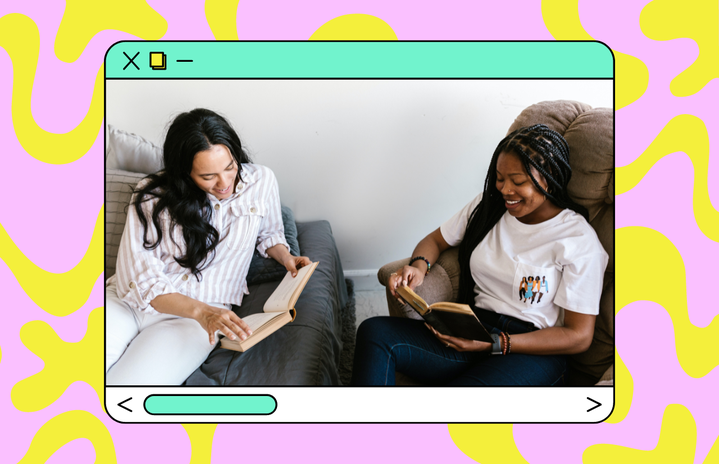In the predominantly male-dominated landscape of mainstream cinema and television, character depictions have long been shaped by the lens of the male gaze. This has resulted in largely stereotypical and one-dimensional depictions of female and male characters alike. As teens, we can remember watching scenes of popular shows and films and feeling disappointed when the protagonists lacked a certain feminine touch. A scene from How I Met Your Mother comes to mind in which the female characters express that they miss being hit on, making it glaringly apparent that it had, of course, been written by a man. Fortunately, this decade has seen a decisive rise in the ‘female gaze’ within mainstream cinema, which culminated last year with the release of Greta Gurwig’s Barbie. The bigger and better sister to the male gaze, the female gaze seeks to challenge and subvert patriarchal norms whilst simultaneously celebrating the complexities of the human experience of all genders – imagine!
Traditionally, male characters have been at the centre of cinematic stories, embodying themes of stoicism, authority and coldness as breadwinners, playboys, and rugged action heroes – think Mission Impossible, Sherlock Holmes, James Bond, and Gladiator. The list goes on. The straying from this archetype has been so refreshing for audiences in recent years. Through the female gaze, male protagonists are presented in a way that reflects the complexities of male identity and experience, offering nuanced and empathetic portrayals of masculinity. From Normal People to Saltburn, male characters written and directed by women have offered a fresh perspective that has resonated with audiences, catapulting these shows to mainstream success, and fostering intense obsessions that have even driven people to buy Jacob-Elordi’s-bathwater scented candles. For International Women’s Day, we want to reflect on some of this decade’s most lovable men ‘written by women’, TikTok’s biggest compliment for modern men.
In recent female-directed TV shows, male characters have challenged the concept of traditional masculinity by straying from stereotypes and offering new portrayals of what an attractive man can be on screen. These characters often show emotional vulnerability and engage openly in conversations about their feelings, defying the usual expectations of stoicism. In Normal People, directed by Lenny Abrahamson and Hettie Macdonald and based on the book of the same name by Sally Rooney (if you haven’t seen it yet, stop what you are doing and do not return until you have finished it), Connell Waldron, played by Paul Mescal, overcomes the traditional notions of male passivity. His navigation of the complex relationship he shares with Marianne with depth and sensitivity adorned him to audiences who revelled in the depiction of a man successfully navigating emotional intimacy like a breath of fresh air. Connell’s willingness to be emotionally vulnerable with Marianne diverges from the stereotype of emotionally unavailable men – a rare sign of hope for the men in the world!
Unlike most male protagonists, Connell engages in thoughtful conversations with Marianne beyond the surface level, exhibiting a precious display of male tenderness. This is furthered by the sensitive depictions of his therapy sessions as he battles with depression and anxiety, allowing audiences to witness the intricacies of his emotional journey. Unlike stereotypical depictions of men, Connell’s mental health struggles are not belittled or brushed aside, representing a positive step in destigmatising men’s mental health in popular media. Connell’s depth and vulnerability have firmly placed him as one of the greatest heartthrobs of recent TV history (though the fact Paul Mescal played him certainly helped situate him there).
A recap of cinema’s most loved men wouldn’t be complete without mention of Laurie Lawrence from Greta Gerwig’s Little Women. Timothée Chalamet’s role in the film exemplifies the power of the female gaze in capturing male sensitivity. Gerwig’s direction infuses Laurie with a vulnerability and authenticity that has captured the hearts of audiences worldwide. Chalamet’s tousled hair, earnest expressions, and playful mannerisms embody Laurie’s warmth and emotional complexity, which has made him irresistible to audiences seeking a change from typical love interests. Laurie isn’t necessarily strong, powerful, or driven, but he is unfalteringly devoted, kind, and honest. He makes up for what he lacks in physical stature in buckets of sincerity and affection. Scenes such as Laurie’s heartfelt confessions of love to Saoirse Ronan’s Jo or his playful interactions with the March sisters showcase a depth of emotion rarely seen in male characters of his time.
Similarly, Fleabag, written by Phoebe Waller-Bridge, the Priest, played by Andrew Scott, challenges traditional ideas of masculinity. Despite being a man of God, he is funny, sexy and anything but traditional. He openly battles with doubts and personal struggles, sharing them with Fleabag in intimate moments of connection. Unlike other male characters, he defies the stereotype that men in positions of authority are emotionally distant and cold, bringing warmth and intimacy to the role. These male protagonists are often more developed than their female counterparts in male-directed depictions. For the most part, female love interests typically lack depth, their only purpose being to serve as objects of desire for the male lead, resulting in overly sexualised depictions. However, in female-directed shows, such as Fleabag and Normal People, though the male characters serve as love interests, they are constructed as fully developed characters, and we see more of them than just their relation to their female partner.
The character of Simon Hastings, played by Regé Jean-Page, in Bridgerton, is another male love interest who embodies the ideal man as written by a woman. He is portrayed as strong, confident, vulnerable, and emotionally complex, somewhat reminiscent of Pride and Prejudice’s Mr Darcy due to his period drama backdrop. In his relationship with Daphne Bridgerton, he embraces his emotions and vulnerabilities and is emotionally available for Daphne, providing her with reassurance and support. Though Simon has his flaws (as all men do), he embodies the concept of ‘If he wanted to, he would’ – he shows a willingness to grow and change to be the best husband he can be for Daphne, putting her needs first. As well as being physically attractive, Simon’s character is emotionally intelligent and compassionate, and embodies the characteristics that any woman would want in a man.
We have also discovered, unsurprisingly, that female directors are adept at constructing male characters that appeal to female audiences by tapping into desires and fantasies while challenging traditional norms. In Fleabag, Phoebe Waller-Bridge crafts the Priest (obsessively nicknamed ‘Hot Priest’ by the internet) as a magnetic figure, particularly evident in the iconic kneel scene, offering a masterclass in understanding Fleabag’s inner world of desire and vulnerability. Fleabag (and all of us) swoon over Andrew Scott as she draws attention to ‘his neck… his beautiful neck!’. Waller-Bridge’s direction contests normative gender dynamics and calls into question the misogyny of the male gaze by presenting male leads as objects of desire without completely dehumanising them. It is possible after all!
This role reversal offers a refreshing break from seemingly never-ending, full-frontal sex scenes that focus solely on the women. In Saltburn, while Emerald Fennell’s construction of Felix as a desirable protagonist relies heavily on Jacob Elordi’s natural good looks, her directive choices brilliantly highlight his most beautiful and masculine features for the audience. Montages of Elordi bathed in golden light frame him as some sort of sexy angel (making his party costume even more appropriate). Close-ups of his body hair and sweat capture the attention and imagination of the audience as we see him through the lens of his admirer, Oliver. Unsurprisingly, TikTok went crazy for Felix’s eyebrow piercing, which Emerald Fennell reportedly had to fight to keep in the film – and thank God she did! It’s become almost as famous as Connel’s chain in Normal People – an accessory with its own Instagram fan account. Female directors’ attention to detail catches the audience’s eye, embellishing fictional men with physical details and accessories that enhance their desirability.
The popularity of many of these male characters also stems from their ability to express love, captured brilliantly by dialogue penned by women. The compliment of being ‘written by a woman’ refers to how the male love interests use their words in an attractive way to the modern woman. In series such as Bridgerton, creator Shonda Rhimes has been praised online for her rhetoric ‘masterpieces’, notably the speeches delivered by Simon, the Duke of Hastings, where he longs for Daphne Bridgerton, saying, “I burn for you”. This line transformed into a cultural phenomenon, becoming one of the most popular in the series as people gushed over the mastery of the script.
The series Normal People gives us Connell, another ideal male love interest. Connell protects Marianne, notably when he stands up to her abusive brother, Alan. He is a lover, not a fighter, but when Marianne is in danger, we see his protective side emerge. His demeanour changes slightly, and in a calm, low voice that we haven’t heard before, Connell tells Marianne to “get in the car”. When he joins her later, his words to her embody just the kind of man he is – he reassures Marianne, “Everything’s gonna be all right, trust me. Cause I love you, and I’m not gonna let anything like that happen to you again”. This line has captured the hearts of audiences, showing his unwavering commitment and loyalty to Marianne. There is a tenderness to the delivery of this line from Mescal, which we would rarely, if ever, see in a male-led show. Connell’s priority is the safety and well-being of Marianne, and this exchange offers a welcome alternative to the unfeeling coldness and often violent reactions of male protagonists to which we’ve become accustomed, hence feeding the audience’s hunger for connection and emotional intimacy.
Whilst celebrating International Women’s Day, it is crucial to celebrate the achievements of female directors and writers and acknowledge their transformative impact on portraying male characters in film and TV. By offering nuanced portrayals of men, women in the industry have challenged stereotypes, fostered empathy, and reshaped perceptions of masculinity. The female gaze captures the complexities of gender and identity and offers diverse narratives, which enriches our understanding of the human experience that has resonated with audiences everywhere. Through amplifying the voices of women writers and directors, we recognise their contributions to the world of cinema and their much-needed reshaping of established norms for women and men. With any luck, the female gaze will continue to be celebrated in future TV and film, and we can’t wait to witness the future work of talented female writers and directors everywhere.
Written By: Daisy Lilley and Saisha Gulamhussein
Edited By: Aimee Missen



